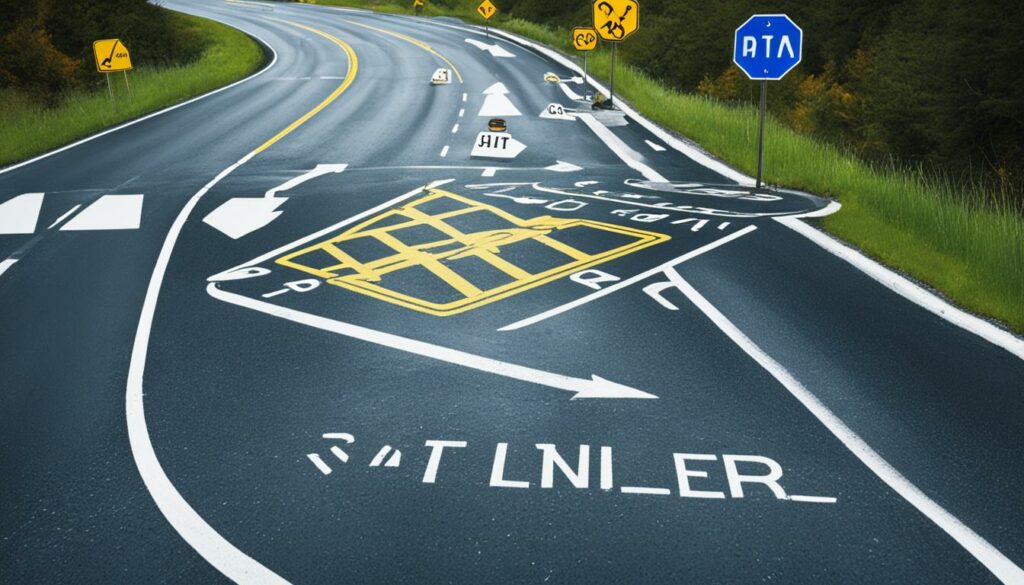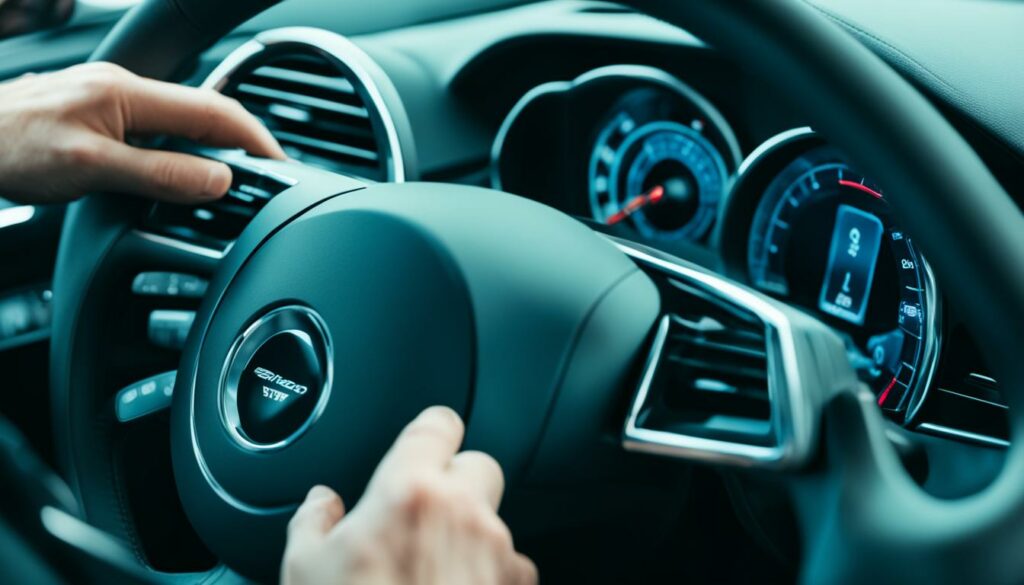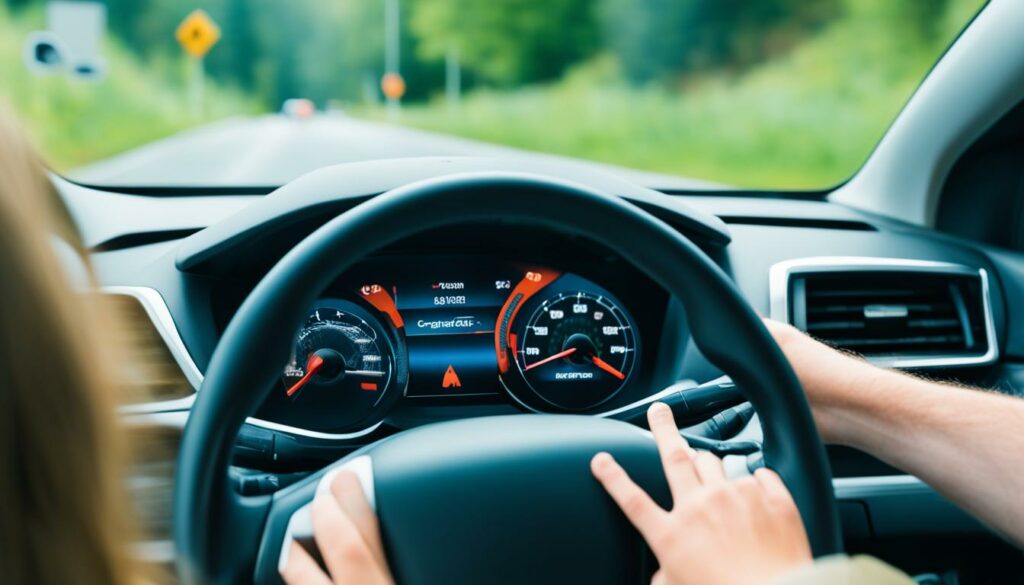Teen Driving 101: How to Teach Your Teenager to Drive
Before letting your teenager get behind the wheel, it’s important to ensure they are knowledgeable about and comfortable with the vehicle and its controls. Start by teaching them the basics, such as adjusting the seat and mirrors, and familiarizing them with dashboard controls, turn signals, headlights, and other safety features. Show them where important documents like the registration and insurance card are located.
Key Takeaways:
- Start by teaching your teen the basics of adjusting seat and mirrors, and familiarizing them with dashboard controls.
- Show them where important documents like the registration and insurance card are located.
- Review the current driving rules and regulations before instructing your teen.
- Take your teen to low-speed, low-traffic areas to practice driving skills.
- Gradually introduce your teen to more complex driving situations, such as highway driving.
Review the Rules of the Road

Before teaching your teenager to drive, it’s essential to ensure they have a strong understanding of the rules of the road. Traffic laws and regulations can change periodically, so it’s crucial to stay updated. By reviewing these rules, you can teach your teen to drive safely and responsibly.
Here are some key concepts to cover:
- Right of Way: Teach your teen about yielding to other drivers, pedestrians, and cyclists at intersections, crosswalks, and roundabouts. Explain how different situations dictate who has the right of way.
- Approaching Intersections: Guide your teen on how to approach intersections, including the appropriate speed, checking for cross traffic, and using turn signals.
- Determining Right of Way: Help your teen understand how to determine who should yield and proceed in different scenarios, such as four-way stops or when making left turns.
- Sharing the Road: Emphasize the importance of sharing the road with other road users, including cyclists, pedestrians, and school buses. Teach your teen how to safely interact with these individuals and vehicles on the road.
Remember, when teaching your teen to drive, patience is key. Reinforce the importance of following the rules and regulations to ensure their safety and the safety of others on the road.
Now that your teen is equipped with a refresher on the rules of the road, they’re ready to tackle the next steps in becoming a responsible and confident driver.
Start with a Tour of the Vehicle

Before your teenager starts practicing driving, it’s crucial to ensure they are familiar with the car they’ll be using. Take the time to give them a comprehensive tour of the vehicle, acquainting them with its various features and controls. This will help them feel more comfortable and confident behind the wheel.
Begin by going over the dashboard controls, including the location and function of important buttons and knobs. Show them how to adjust the steering wheel and seats to find the most comfortable driving position. Teach them how to properly adjust the mirrors to ensure excellent visibility.
Next, demonstrate how to operate the turn signals and headlights. Explain the importance of using them to communicate with other drivers on the road and ensure safe driving practices. Familiarize your teen with other safety features such as airbags and seat belts, emphasizing their crucial role in protecting passengers in case of an accident.
Don’t forget to show them how to use the windshield wipers and emergency lights. These features are essential for maintaining visibility in different weather conditions and signaling emergency situations.
Show them how to engage and release the parking brake, as well as how to safely start and turn off the engine. These are fundamental steps in operating a vehicle.
Finally, make sure your teen knows where to find important documents like the registration, insurance card, and the car manual. It’s crucial to have easy access to these documents while driving.
Get a Feel for the Vehicle

Now that your teenager is familiar with the basics of the vehicle, it’s time to start getting a feel for actually driving. This section will guide you through the initial practice sessions that will help your teen gain confidence behind the wheel.
Begin by finding a simple location for your teen to practice, such as an empty parking lot. This provides a controlled environment where they can focus on the fundamentals without the added stress of other vehicles on the road.
Instruct your teen to start by practicing basic driving skills. This includes applying the gas and brakes smoothly, maintaining a steady speed, and steering with control. Encourage them to practice driving straight, turning left and right, and backing up. Remind them to stay focused and be aware of their surroundings.
Gradually make the practice sessions more complex. Have your teen practice pulling into and out of parking spots, simulating the real-world situation of maneuvering into tight spaces. This will help them develop spatial awareness and hone their control over the vehicle.
As your teen becomes more comfortable with these maneuvers, introduce them to different driving situations. This could include practicing lane changes, navigating through intersections, and reacting to unexpected hazards or road conditions. This will help them develop the ability to make quick decisions and adjust their driving accordingly.
Remember to provide clear instructions and constructive feedback during these practice sessions. Encourage your teen to ask questions and address any concerns they may have. Building open communication and trust will help them feel more at ease and confident in their abilities.
Remember, practice makes perfect! The more your teenager practices, the better they will become at driving. Encourage them to keep practicing and remind them that everyone starts as a beginner.
So, let’s get started with your teen’s driving lessons and help them gain the necessary experience and confidence to become a skilled and responsible driver.
Start in Low-Speed, Low-Traffic Areas

Once your teen is comfortable with the basics, it’s time to move on to low-speed, low-traffic areas. This is an essential step in their teenage driving instruction journey, as it allows them to practice their skills in a controlled environment.
When selecting a location for this practice, look for quiet streets with speed limits below 35 mph. These areas provide ample opportunities for your teen to work on specific driving techniques. Start by focusing on staying on one side of the road and anticipating cars exiting driveways. This will help them develop spatial awareness and improve their ability to navigate different scenarios.
Another crucial skill to practice in low-speed areas is approaching stop signs. Teach your teen the importance of pulling up to stop signs, making a complete stop, and scanning for potential hazards before proceeding. Emphasize the significance of maintaining an appropriate speed and always keeping a safe following distance from other vehicles.
Remember to provide continuous guidance and support during these practice sessions. Encourage open communication and address any concerns or questions they may have. By practicing in low-speed, low-traffic areas, your teen will gain confidence and build a solid foundation for their future driving experiences.
| Skill | Description |
|---|---|
| Staying on one side of the road | Practice staying in the correct lane and maintaining proper positioning |
| Anticipating cars exiting driveways | Develop the ability to recognize and respond to vehicles pulling out of driveways |
| Approaching stop signs | Learn to pull up to stop signs, make a complete stop, and scan for hazards |
| Maintaining appropriate speed | Understand the importance of adhering to speed limits and adjusting speed as needed |
| Keeping a safe following distance | Practice maintaining a safe gap between your vehicle and the vehicle ahead |
By focusing on these skills in low-speed, low-traffic areas, your teen will develop the necessary foundation for safe and responsible driving.
Beginner Skills Checklist
To ensure that teen drivers develop essential skills and become confident on the road, it’s important to practice a wide range of driving maneuvers and techniques. The following checklist outlines the essential skills for teen drivers and beginner driving skills that should be mastered:
Turns
- Practice making both left and right turns at intersections with stop signs or traffic lights.
Braking Smoothly
- Learn to apply the brakes gently and smoothly, coming to a complete stop without jerking or skidding.
Accelerating Smoothly
- Master the art of smoothly accelerating without jerking the vehicle.
Approaching Intersections
- Practice approaching intersections controlled by stop signs or traffic lights, following the right-of-way rules.
Determining Right of Way
- Understand how to determine who has the right of way in different driving scenarios, such as yielding to pedestrians or vehicles on the main road.
Driving on Single-Lane and Multi-Lane Roadways
- Develop skills for driving on both single-lane and multi-lane roadways, including maintaining lane position and safely changing lanes.
Changing Lanes and Merging Into Traffic Safely
- Practice safely changing lanes and merging into traffic, paying attention to blind spots and using turn signals.
Maintaining Appropriate Speed
- Learn how to maintain a safe and appropriate speed depending on the road conditions and speed limit.
Scanning for and Identifying Hazards
- Develop the ability to scan the road for potential hazards and identify them in advance, such as pedestrians, cyclists, or sudden road obstacles.
Keeping a Safe Following Distance
- Understand the importance of maintaining a safe following distance to allow for ample reaction time and to avoid rear-end collisions.
Sharing the Road with Cyclists, Pedestrians, and School Buses
- Learn how to safely share the road with cyclists, pedestrians, and school buses, respecting their right of way and understanding their vulnerabilities.
Driving in a School Zone
- Practice driving in school zones, adhering to reduced speed limits and watching out for children.
Reacting to Approaching Emergency Vehicles
- Understand how to react safely and promptly when emergency vehicles like ambulances or fire trucks approach with lights and sirens.
Beginner Skills Checklist
Here’s a summarized table of the essential skills for teen drivers and beginner driving skills:
| Skills |
|---|
| Turns |
| Braking Smoothly |
| Accelerating Smoothly |
| Approaching Intersections |
| Determining Right of Way |
| Driving on Single-Lane and Multi-Lane Roadways |
| Changing Lanes and Merging Into Traffic Safely |
| Maintaining Appropriate Speed |
| Scanning for and Identifying Hazards |
| Keeping a Safe Following Distance |
| Sharing the Road with Cyclists, Pedestrians, and School Buses |
| Driving in a School Zone |
| Reacting to Approaching Emergency Vehicles |
Mastering these essential skills will help teenage drivers approach the road with confidence and ensure their safety as well as the safety of others.
Driving on the Highway
Once your teen is comfortable with basic driving skills, it’s time to introduce them to the highway. While it can be an intimidating experience, with proper guidance and practice, your teen can become confident and skilled at highway driving.
Start by selecting quieter times of the day to practice on the highway. This will allow your teen to become familiar with merging into traffic, staying in the lane, and navigating at higher speeds. Emphasize the importance of maintaining safe following distances and using proper signaling when changing lanes.
Once both you and your teen are comfortable with the basics, gradually expose them to busier traffic situations. This will provide them with the opportunity to practice dealing with faster-moving vehicles, multiple lanes, and more complex maneuvering.
Remember to emphasize the importance of defensive driving techniques, such as scanning the road ahead, checking blind spots, and anticipating potential hazards. Encourage your teen to remain calm and focused while driving on the highway, as distractions can be more prevalent in this environment.
Tips for Teaching Your Teen to Drive on the Highway:
- Start with quieter times of the day to practice merging into traffic and staying in the lane.
- Focus on maintaining safe following distances and using proper signaling.
- Gradually expose your teen to busier traffic situations, allowing them to practice more complex maneuvers.
- Emphasize defensive driving techniques, such as scanning the road ahead and checking blind spots.
- Encourage your teen to remain calm and focused while driving on the highway.
By providing your teen with the necessary guidance and practice, you can help them gain the skills and confidence needed to navigate the highway safely.
Advanced Skills Checklist
Once your teen has mastered the basic driving skills and is comfortable on the highway, it’s time to take their driving abilities to the next level. Encourage them to practice advanced driving skills that will help them navigate more challenging situations on the road.
- Merging into Traffic: Teach your teen how to safely merge into traffic, adjusting their speed and timing to seamlessly blend in with other vehicles.
- Identifying Road Signs and Exits: Ensure that your teen is proficient in recognizing and following road signs, including exit signs, to navigate unfamiliar areas confidently.
- Navigating Toll Booths: Show your teen how to approach and navigate toll booths effectively, including understanding payment methods and having the correct change available.
- Passing and Being Overtaken: Instruct your teen on how to safely pass other vehicles on the road while maintaining a proper speed and position.
- Maintaining Proper Speed: Emphasize the importance of adhering to speed limits and adjusting speed according to road conditions.
- Being Courteous to Others: Teach your teen the importance of courteous driving, including using turn signals, yielding the right of way, and respecting other drivers on the road.
- Keeping a Safe Following Distance: Emphasize the need for your teen to maintain a safe distance behind the vehicle in front of them, allowing for ample reaction time.
- Reacting to Different Driving Conditions: Help your teen practice adapting their driving skills to various conditions, such as rain, snow, fog, or heavy traffic.
By focusing on these advanced driving skills, your teen will become a more confident and capable driver, equipped to handle diverse road scenarios with ease.
Advanced Challenges
To prepare your teenager for unfamiliar or challenging driving situations, consider having them practice driving in challenging weather conditions such as rain, windy days, fog, light snow, or sleet. These conditions can make driving more difficult and require extra caution. Practice sessions in challenging weather will help your teenager build confidence and develop skills to navigate these conditions safely.
Additionally, expose your teenager to driving during different times of the day and night. Different lighting conditions and traffic patterns can present unique challenges on the road. Encourage your teenager to practice driving during daytime, dusk, and nighttime hours to become comfortable with varying visibility.
Another important aspect is gaining experience by driving with other people in the car. This simulates real-life scenarios where distractions may be present. It’s essential for your teenager to learn how to manage distractions effectively and focus on the road.
“The more exposure your teenager has to different driving conditions and scenarios, the better equipped they will be to handle unexpected situations.” – Paul Anderson, Driving Instructor
Finally, give your teenager the opportunity to drive different vehicles. Each vehicle has its own characteristics and handling differences, so it’s helpful for them to gain experience in a variety of cars. This will enhance their adaptability and confidence when driving vehicles they may not be familiar with.
By exposing your teenager to these advanced challenges, you are preparing them to face a wide range of driving situations with confidence and competence. It’s essential for them to gain experience in handling different scenarios and conditions in order to become skilled and responsible drivers.
How Do I Know When My Teen Is Ready to Drive Alone?
As a parent, determining if your teen is ready to drive alone is a big decision that requires careful consideration. While there is no exact formula, there are several factors you can take into account to gauge their readiness:
- Practice in varying conditions: Has your teen had enough practice in different weather conditions, such as rain or snow? Are they comfortable driving at night or during rush hour traffic?
- Hazard detection and reaction: Can your teen quickly identify potential hazards on the road and respond appropriately? Do they exhibit good decision-making skills while driving?
- Consistent adherence to safe driving habits: Does your teen consistently follow safe driving habits and rules, such as maintaining the speed limit, using turn signals, and checking blind spots?
- Responsibility in other areas of life: Is your teen generally responsible and mature in other aspects of their life, such as schoolwork, chores, and time management?
- Agreement to follow safe driving habits and rules: Has your teen acknowledged and agreed to adhere to the safe driving habits and house rules you’ve established?
Ultimately, it’s up to you, as the parent, to assess your teen’s overall readiness and make an informed decision about whether they are prepared to drive alone. Trust your instincts and consider these factors to ensure their safety and the safety of others on the road.
Conclusion
Teaching your teenager to drive is an important milestone in their life, and it can be both challenging and rewarding for both of you. By following a structured approach and being patient, you can help them develop the necessary skills to become a confident and responsible driver.
Start with the basics, ensuring they are familiar with the vehicle and its controls. Review the current rules of the road together and ensure they understand the importance of safe driving practices. Practice in low-speed and low-traffic areas before gradually progressing to more complex driving situations.
Most importantly, make sure your teen is ready to drive alone. Gauge their readiness by considering their experience, ability to react to hazards, adherence to safe driving habits, and overall responsibility. Once you feel confident in their abilities, allow them to drive solo with the knowledge that you have equipped them with the necessary skills and knowledge to be a safe driver.
Remember, teaching your teen to drive is a journey that requires clear instructions, patience, and leading by example. With your guidance, they can become a competent driver who respects the rules of the road and keeps themselves and others safe. Good luck!
FAQ
How do I teach my teenager to drive?
Teaching your teenager to drive involves starting with the basics, such as adjusting the seat and mirrors and familiarizing them with the vehicle’s controls. You should also review the current driving rules and regulations, give them a comprehensive tour of the vehicle, and gradually have them practice driving in different situations.
Where should I start teaching my teenager to drive?
It’s recommended to start in a more simple location, such as an empty parking lot, where your teenager can practice basic skills like applying the gas and brakes, driving straight, turning, and backing up. Once they are comfortable with these skills, you can move on to quieter streets with slower speed limits to practice more complex driving situations.
What skills should my teenager learn when driving?
Your teenager should learn essential skills such as maintaining appropriate speed, scanning for hazards, keeping a safe following distance, navigating intersections, changing lanes, merging into traffic safely, and sharing the road with others. They should also be familiar with road signs, driving in different weather conditions, and reacting to different driving scenarios.
When should my teenager be ready to drive alone?
It’s ultimately your decision as a parent to determine when your teenager is ready to drive alone. Factors to consider include their proficiency in different driving conditions, their ability to detect and react to hazards, their adherence to safe driving habits, and their responsibility in other areas of their life. Trust your instincts and ensure your teen is confident and responsible before allowing them to drive alone.
How can I prepare my teenager for challenging driving conditions?
To prepare your teenager for unfamiliar or challenging driving situations, consider having them practice driving in bad weather conditions such as rain, fog, or light snow. Additionally, expose them to driving during different times of the day and night, with other people in the car, and in different vehicles. It’s important for them to gain experience in handling different scenarios and conditions.







